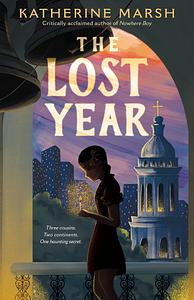Take a photo of a barcode or cover
adventurous
challenging
emotional
inspiring
reflective
sad
tense
medium-paced
Plot or Character Driven:
A mix
Strong character development:
Yes
Loveable characters:
Complicated
Diverse cast of characters:
Complicated
Flaws of characters a main focus:
Complicated
challenging
informative
reflective
medium-paced
Plot or Character Driven:
Character
emotional
informative
inspiring
sad
fast-paced
Plot or Character Driven:
A mix
Strong character development:
Yes
Loveable characters:
Yes
Diverse cast of characters:
Yes
Flaws of characters a main focus:
No
This was a gripping story told in flashbacks from "now" when Matthew is a middle-school student during the first few months of the Covid Pandemic, and therefore staying home with his mom and great-grandmother and doing online learning in New Jersey, to "then" when his great-grandmother, called "GG", was his same age, living in Ukraine during Stalin's reign and the devastating famine.
The set-up for this novel is realistic and recognizable to anyone currently in grades 4 to 9 in the United States; Matthew is supposed to help GG sort through the boxes of possessions she brought when she moved in with them at the start of Covid, even though he'd rather play Legends of Zelda on his Nintendo Switch. He is also increasingly upset that his father (divorced, but usually living nearby) is stuck in France because of the pandemic, and therefore Matthew gets no relief from his hovering, stressed-out, but loving mother.
But GG's boxes of letters, journals, and newspaper clippings are fascinating and relevant and are revealed in tantalizing bits and pieces as different chapters focus on 3 different girls from 1932 and then Matthew from 2020.
GG, born in 1920, is carrying a secret about her past that will be revealed in the boxes of papers - and her lack of enthusiasm for the moment of revelation causes her to repeatedly put the brakes on.
It's a page-turner, despite those brakes, and I think young readers will be captivated.
I had a quibble with the book; The framing device that GG's boxes contain several formats of ephemera to sort through ("diaries...letters...histories...articles...official documents") would've been SO GREAT to then present *as* those formats...but instead, it's implied that GG and Matthew are reading a piece from one of those formats - specifically in the order GG directs - and then the chapter is told as if it were a novel with that individual person as the main character.
This results in the historical bits feeling pre-digested and uniform in a way, even though one girl is in Kyiv, Ukraine in 1932, her cousin is in New York in 1932, and their descendant Matthew is in New Jersey in 2020. I would have loved to read each bit as Matthew found it - a letter, a journal entry, an article, a document, and then hear Matthew discuss it with GG! It's so obvious a possibility, it made me wonder throughout why Katherine Marsh didn't use that technique.
Similarly, one small detail was very obviously left out - GG loved to listen to piano music, but did she play? - that would've given away the entire mystery right away.
The mystery of the third cousin will probably be as obvious to most adult readers as it was to me, but that doesn't detract from the story.
The set-up for this novel is realistic and recognizable to anyone currently in grades 4 to 9 in the United States; Matthew is supposed to help GG sort through the boxes of possessions she brought when she moved in with them at the start of Covid, even though he'd rather play Legends of Zelda on his Nintendo Switch. He is also increasingly upset that his father (divorced, but usually living nearby) is stuck in France because of the pandemic, and therefore Matthew gets no relief from his hovering, stressed-out, but loving mother.
But GG's boxes of letters, journals, and newspaper clippings are fascinating and relevant and are revealed in tantalizing bits and pieces as different chapters focus on 3 different girls from 1932 and then Matthew from 2020.
GG, born in 1920, is carrying a secret about her past that will be revealed in the boxes of papers - and her lack of enthusiasm for the moment of revelation causes her to repeatedly put the brakes on.
It's a page-turner, despite those brakes, and I think young readers will be captivated.
I had a quibble with the book; The framing device that GG's boxes contain several formats of ephemera to sort through ("diaries...letters...histories...articles...official documents") would've been SO GREAT to then present *as* those formats...but instead, it's implied that GG and Matthew are reading a piece from one of those formats - specifically in the order GG directs - and then the chapter is told as if it were a novel with that individual person as the main character.
This results in the historical bits feeling pre-digested and uniform in a way, even though one girl is in Kyiv, Ukraine in 1932, her cousin is in New York in 1932, and their descendant Matthew is in New Jersey in 2020. I would have loved to read each bit as Matthew found it - a letter, a journal entry, an article, a document, and then hear Matthew discuss it with GG! It's so obvious a possibility, it made me wonder throughout why Katherine Marsh didn't use that technique.
Spoiler
Similarly, one small detail was very obviously left out - GG loved to listen to piano music, but did she play? - that would've given away the entire mystery right away.
The mystery of the third cousin will probably be as obvious to most adult readers as it was to me, but that doesn't detract from the story.
challenging
dark
emotional
hopeful
informative
inspiring
reflective
sad
tense
medium-paced
Plot or Character Driven:
A mix
Strong character development:
Yes
Loveable characters:
Yes
Diverse cast of characters:
No
Flaws of characters a main focus:
Yes
This is one of the finest books I've read in a long time. Although written for middle schoolers, this wonderfully absorbing and deeply affecting story should appeal to almost anyone searching for a book with real substance. For a story about such a horrific historical period—the Holodomor, or Great Ukrainian Famine, in which the Soviet Union deliberately starved millions of Ukrainians to death—author Katherine Marsh draws the reader in from the start and never allows them to put the book down. Her tone and voice, the fluidity of her language, her vivid characterizations, as well as her mastery of pacing, instill an unquenchable curiosity about the lives of the four central characters, all of whom we come to care deeply about. Even the secondary characters are so well-rendered that the reader becomes invested in many of them as well.
Marsh effectively intertwines three narratives into a single multi-generational tale that builds to a satisfying, if emotionally devastating, climax. In addition to furnishing a remembrance of a period in history that has largely fallen between the cracks, the author also manages to deftly and organically weave in a sub-text about life during the COVID-19 pandemic. Not too shabby!
Without giving too much away, the character of Matthew, an adolescent boy who is forced to live in lockdown with his mother and his great-grandmother (Nadiya), encourages her to reveal the secrets of her past. She slowly unravels the untold tales of herself and her cousin Mila living through the Holodomor in 1933, as well as that of their cousin Helen, whose family was living in New York City at the same time. The stories gradually converge on a shocking family secret that's been held by Nadiya for 90 years. Not only is the climax of this book extremely moving (keep the Kleenex on hand, folks!), but it sets up a denouement that equals it—a rare and virtuosic literary feat.
The author's notes at the end of the book are fascinating and enlightening. They reveal just how personal this work was to her, as well as how much blood, sweat, and tears were shed in constructing this utterly compelling story. This is fiction that hits you as if it were real life. A must-read for just about anyone and destined to become a classic.
Marsh effectively intertwines three narratives into a single multi-generational tale that builds to a satisfying, if emotionally devastating, climax. In addition to furnishing a remembrance of a period in history that has largely fallen between the cracks, the author also manages to deftly and organically weave in a sub-text about life during the COVID-19 pandemic. Not too shabby!
Without giving too much away, the character of Matthew, an adolescent boy who is forced to live in lockdown with his mother and his great-grandmother (Nadiya), encourages her to reveal the secrets of her past. She slowly unravels the untold tales of herself and her cousin Mila living through the Holodomor in 1933, as well as that of their cousin Helen, whose family was living in New York City at the same time. The stories gradually converge on a shocking family secret that's been held by Nadiya for 90 years. Not only is the climax of this book extremely moving (keep the Kleenex on hand, folks!), but it sets up a denouement that equals it—a rare and virtuosic literary feat.
The author's notes at the end of the book are fascinating and enlightening. They reveal just how personal this work was to her, as well as how much blood, sweat, and tears were shed in constructing this utterly compelling story. This is fiction that hits you as if it were real life. A must-read for just about anyone and destined to become a classic.
So much to like here.
It's timely in terms of what is currently happening in the Ukraine, as well as the role of disinformation, reporting and sorting out the actual facts of events.
Marsh doesn't shy away from the horrors of 1930s Russia and what happened to Ukrainian people, and her use of multiple points of view really helped create well rounded characters and plot. As an adult reader, I probably should have.
I'd give this to readers of Alan Gratz who wouldn't mind slightly slower paced stories as well as readers who liked The Blackbird Girls by Ann Blankman and A Night Divided by Jennifer Nielson.
It's timely in terms of what is currently happening in the Ukraine, as well as the role of disinformation, reporting and sorting out the actual facts of events.
Marsh doesn't shy away from the horrors of 1930s Russia and what happened to Ukrainian people, and her use of multiple points of view really helped create well rounded characters and plot. As an adult reader, I probably should have
Spoiler
seen where GG's story was going a lot sooner, but I didn't and her revelation about what happened between Nadiya and Mila blindsided meI'd give this to readers of Alan Gratz who wouldn't mind slightly slower paced stories as well as readers who liked The Blackbird Girls by Ann Blankman and A Night Divided by Jennifer Nielson.
This was such a thought provoking and timely story. I loved the way the author tied the entire story together and I really think preteens will love getting to know Nadiya, Mila, & Helen's story through the lens of Matthew.
It took me awhile to get into this book, but I am so glad I didn’t my give up on it. Such a great story mixing history with present day.



